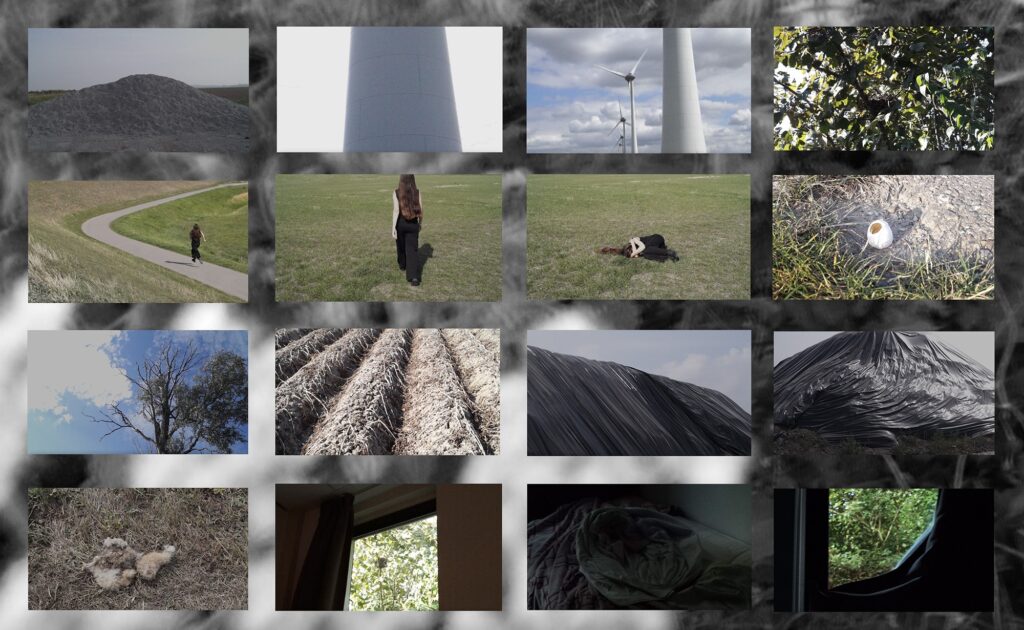Anna Kakhiani

The runnings of the stranger
video, performance documentation, text
~7’ min
In every era, the notion of utopia is a certain variation of the ideal present, the ideal past, and the ideal future, as well as the relationship between these three concepts. Ultimately, the line between utopian ideas and dystopian motives has blurred. These two ideologies exist in close tandem, and the key to understanding the essence of each is its antagonist.
On February 24, 2022, millions of Ukrainians began to rapidly lose their essence of home due to Russia’s full-scale invasion. And with the same force as the loss, love and understanding of the value of what we had began to manifest. Everyone asked themselves “what awaits us?”. This feeling overtook me as well—the feeling of a lost utopia, a lost essence of home.
As a refugee, you find yourself in the middle of an alien environment, and it doesn’t know much about you, and you don’t know anything about it – now you are a stranger.
Your perception of the environment is different from that of a tourist who always comes as a consumer and explorer for a portion of pleasure and inspiration. Your new status doesn’t change the environment you’re in, but it gives you completely different perspectives. And a country with a great lifestyle design starts to seem like an illusion and a dystopian game you got into in a bad dream, a beautiful scenery, behind which something threatening is still hiding.
The performative practices and self-documentation in this work have become a method of exploring the elusive feeling that stunning change brings us, an attempt to examine ourselves in new coordinates of space and time, to grasp the slipping sense of home.
This is the question I keep repeating to myself: is home now forever about testing the boundaries?

The Traces of Humanity
Installation 5 types of rocks from periods of 5 extinctions, mirrored object
From left to right: the massive Ordovician extinction, the Late Devonian extinction, the Permian mass extinction, the Late Triassic extinction, and the Late Cretaceous extinction.
“There are no traces of cataclysm in stone.
They are in you and me.
The world will turn into a dream today.
Try to remember it.
Someone will wake up again in millions of years,
To light the fire.”
Anna Kahiani
“…when life achieved self-awareness through the human mind, it condemned its most beautiful creations to death.”
Edward Osborne Wilson
As early as the beginning of our era, Pliny said in “The Natural History” that stones preserve traces of catastrophes that caused the extinction of species. When we say that we are in the midst of the sixth mass extinction of species, do we recognize ourselves as the cause? What will be the traces left by humanity for thousands of years to come?
The Anthropocene is believed to have begun with the Industrial Revolution, the introduction of modern technology – turbines, railroads, chainsaws, and weapons – that made humanity a planet-changing force.
We are facing a large-scale ecological catastrophe and keep talking about awareness in all spheres of life and about salvation scenarios for humanity, such as space exploration and life on other planets, satellites, and asteroids. But what will we take with us into the future, what will we take with us into space?
I think more and more that we still haven’t learned to exist with responsibility for every choice here and now, even for every personal decision, whether it’s a direct environmental issue or a political position. Because even the smallest choices have an impact on the dynamics of all life on planet Earth.
Russia’s war against Ukraine has been going on for a year now. And as much as many people would not like to think of the war as a political one, you will find countless environmental tragedies. Since the start of the full-scale invasion, 42 million tons of greenhouse gas have been released into the air; about 200,000 km2 of Ukraine’s territory will need demining, including nature reserves and wildlife; entire ecosystems have been destroyed and valuable habitats lost due to the hostilities; 2.4 million hectares of forests have been severely damaged; a total of 2,300 crimes against the environment have been documented.
Many thanks for the organization of the expedition and professional advice to two geologists – Bente Schriever and Marc V. Heemskerk.
And also, special thanks to Bouke Lacet, who supported us with cutting pieces of stones for a miniature artwork that will be placed in the Moon Gallery.